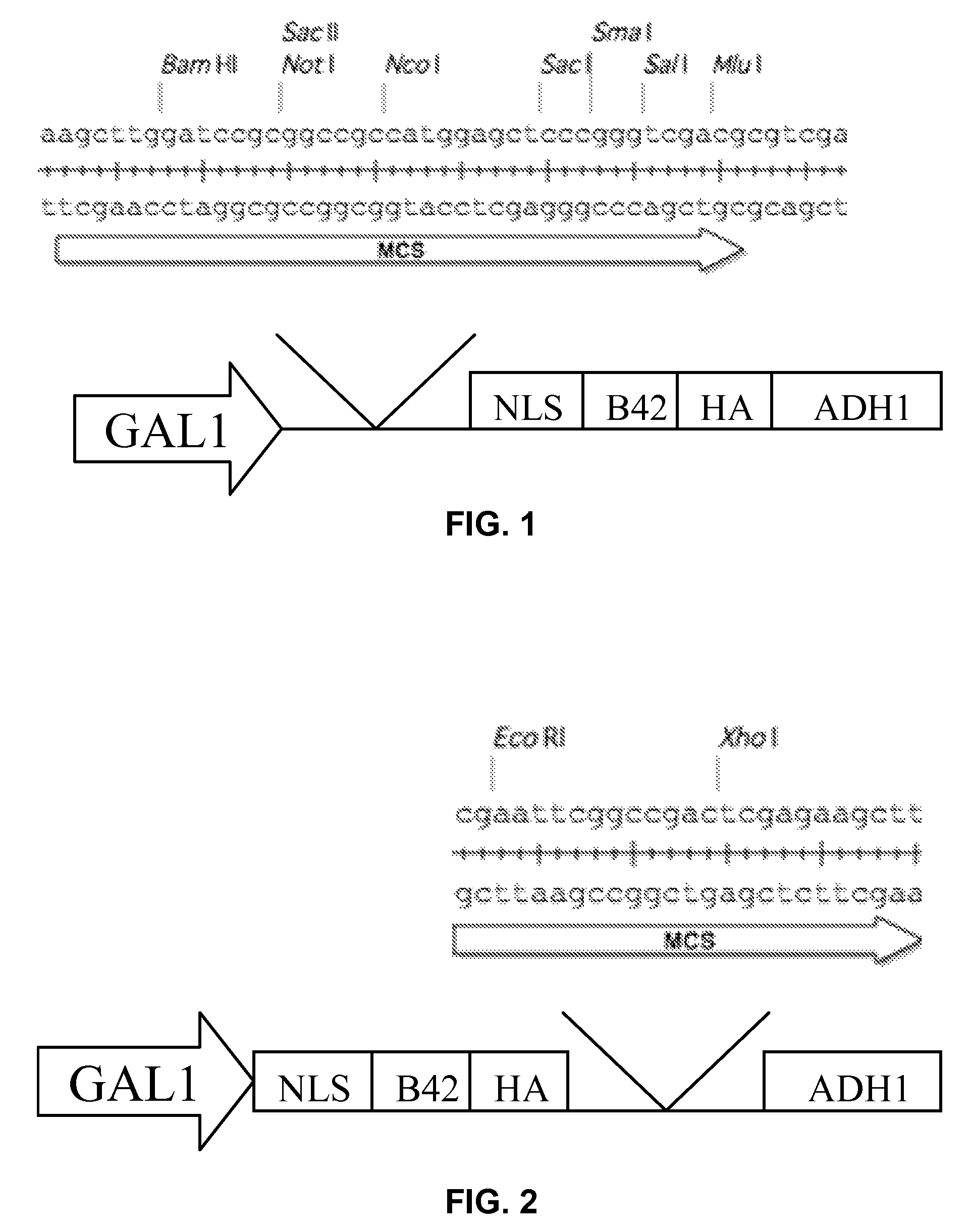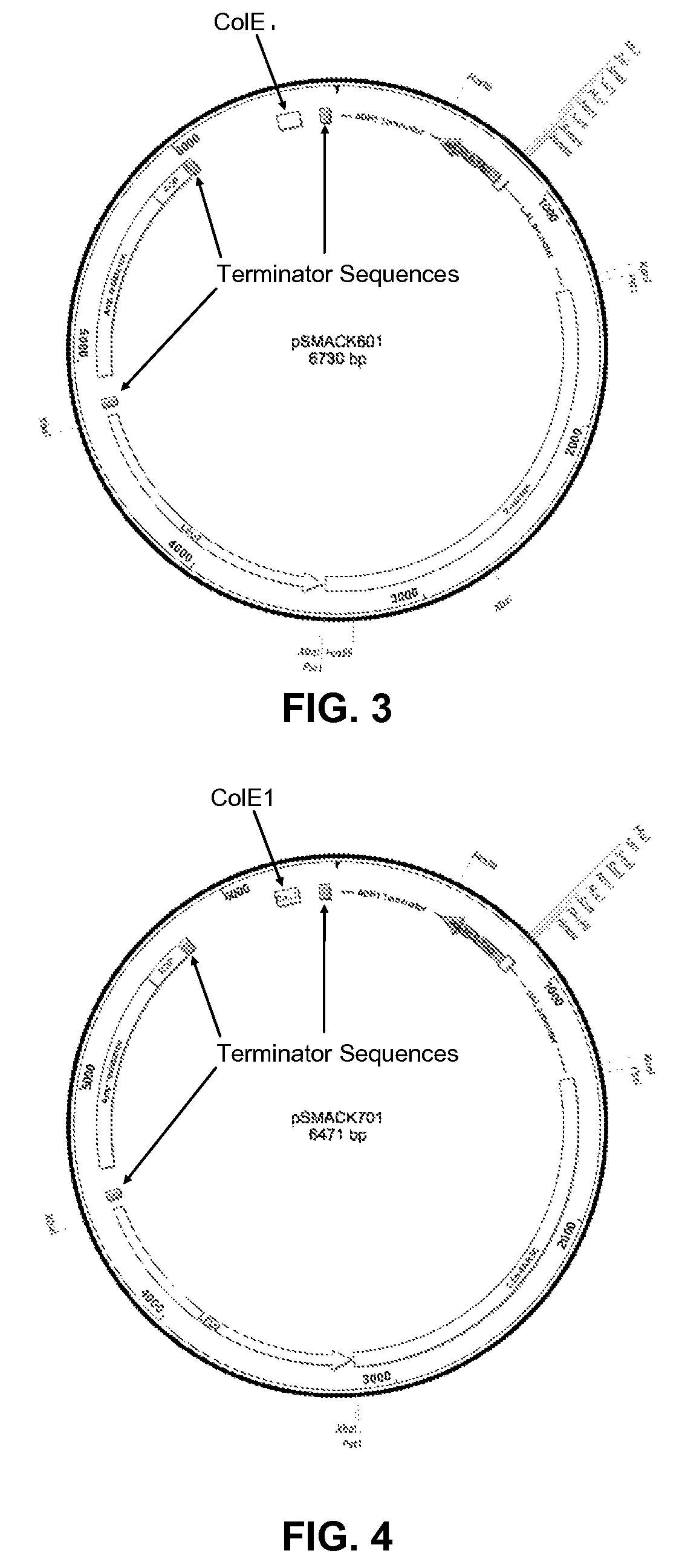System for pulling out regulatory elements using yeast
a technology of regulatory elements and systems, applied in the field of systems for pulling out regulatory elements using yeast, can solve the problems of difficult identification and characterization of genes, inability to adapt, and insufficient levels of inherent efficiency, and achieve the effect of easy and quick screening of an entire genom
- Summary
- Abstract
- Description
- Claims
- Application Information
AI Technical Summary
Benefits of technology
Problems solved by technology
Method used
Image
Examples
example 1
[0116]Yeast Strains
[0117]The yeast strains used in the invention can be grown and maintained with standard methods. Saccharomyces cerevisiae are particularly useful in the invention. S. cerevisiae strains with functional GAL4 and GAL80 genes and that are auxotrophic for histidine, leucine, and tryptophan are particularly useful in the invention. Examples of such strains include, without exception, strains W303 and K2346.
example 2
[0118]Construction of bait vectors pSMACK601, pSMACK701, pSPANK201, and pSPANK301
[0119]The four bait vectors are derivatives of the pSMART®LC-Amp cloning vector (Lucigen Corp., Middleton, Wis.), and are designed to allow for galactose-inducible expression of a transcription factor of interest cloned into a multiple cloning (“multi-cloning”) site. The expressed protein is fused to a tag containing a yeast nuclear localization signal, the B42 acid blob domain, and an HA tag at either the carboxyl- or amino-terminus of the protein (FIGS. 1 and 2, respectively). All four plasmids offer the following features: (i) the LEU2 gene, which acts as a selectable marker in yeast; (ii) the Ampicillin resistance gene and Col E1 origin of replication to allow for selection and propagation in E. coli.; (iii) a protein expression cassette comprising a GAL1 promoter, which allows for galactose inducible expression, a multiple cloning site, a hemagglutinin (HA) epitope tag, a nuclear localization signa...
example 3
Creation of Reporter Vector pKAD202
[0136]We designed a novel plasmid, pKAD202 (FIG. 9, TABLE 5, and SEQ ID NO:15), that contains a histidine reporter gene under the control of the minimal HIS3 promoter. Within the promoter region, a unique multiple cloning site allows for the insertion of genomic sequences or DNA sequences that contain known transcription factor binding sites for use as positive controls (FIG. 8). Plasmid pKAD202 also contains: (i) the TRP1 gene, which acts as a selectable marker in yeast; (ii) the Kanamycin gene and Col E1 bacterial origin of replication to allow for selection on plates containing kanamycin and propagation, respectively, in E. coli.; and (iii) the yeast ARS6 origin of replication and the CEN4 centromeric sequence (FIG. 9).
[0137]FIG. 8 shows a schematic representation of the HIS3 reporter gene that operably linked to the minimal HIS3 promoter in reporter vector pKAD202. This sequence also contains a novel multiple cloning site to allow the insertion...
PUM
| Property | Measurement | Unit |
|---|---|---|
| pH | aaaaa | aaaaa |
| optical density | aaaaa | aaaaa |
| final volume | aaaaa | aaaaa |
Abstract
Description
Claims
Application Information
 Login to View More
Login to View More - R&D
- Intellectual Property
- Life Sciences
- Materials
- Tech Scout
- Unparalleled Data Quality
- Higher Quality Content
- 60% Fewer Hallucinations
Browse by: Latest US Patents, China's latest patents, Technical Efficacy Thesaurus, Application Domain, Technology Topic, Popular Technical Reports.
© 2025 PatSnap. All rights reserved.Legal|Privacy policy|Modern Slavery Act Transparency Statement|Sitemap|About US| Contact US: help@patsnap.com



